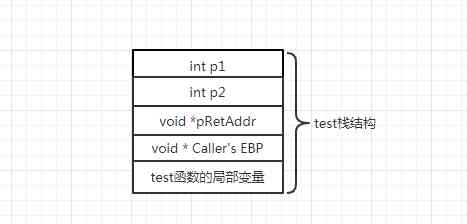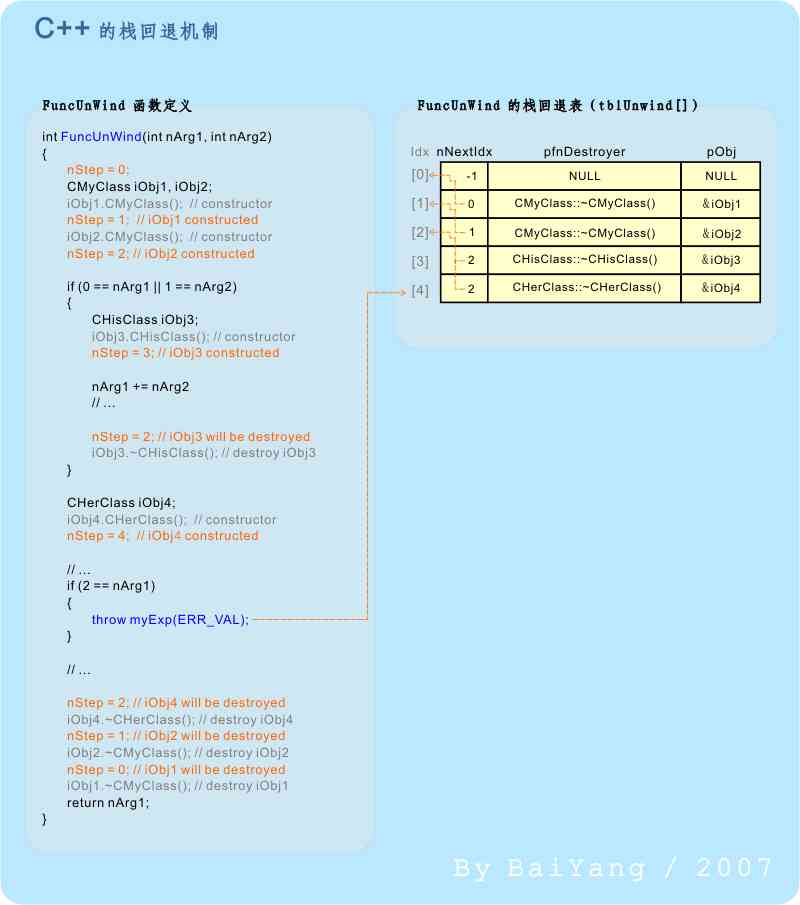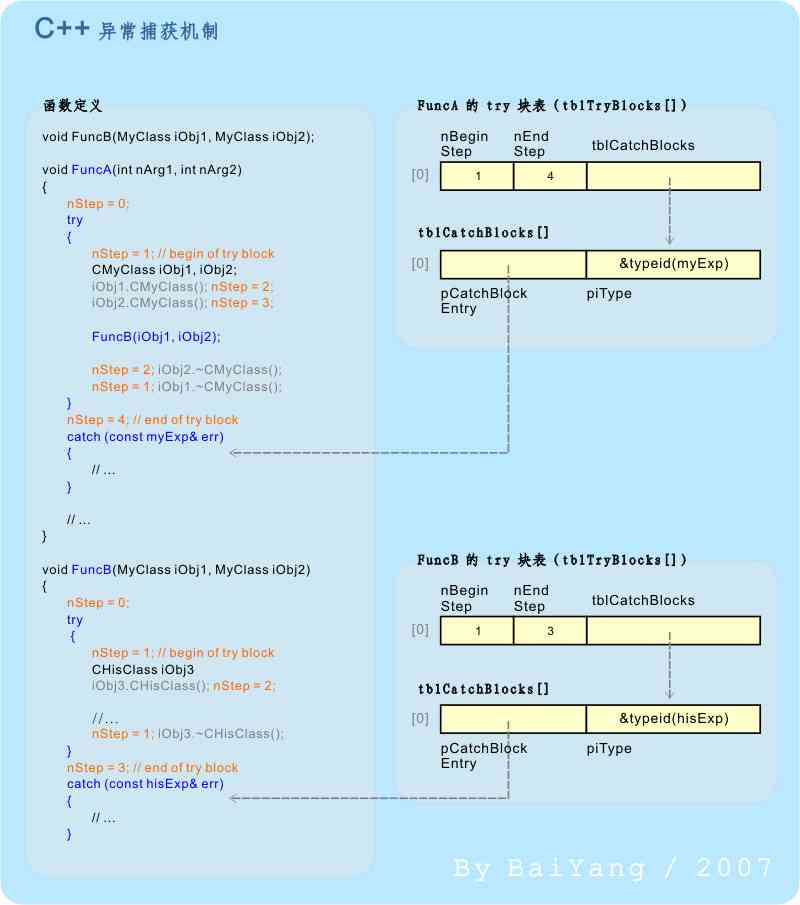当前位置:网站首页>C++ exception implementation mechanism
C++ exception implementation mechanism
2020-11-09 23:48:00 【shzwork】
、C Function calls and returns
To understand C++ Before the exception mechanism is implemented , First of all, we should understand the call and return mechanism of a function , This involves ESP and EBP register . Let's take a look at the flow of function calls and returns .
The following is the call Convention __stdcall Call function test(int p1,int p2) Assembly code for
Suppose the stack pointer before the function is executed ESP by NN
push p2 ; Parameters 2 Push , ESP -= 4h , ESP = NN - 4h
push p1 ; Parameters 1 Push , ESP -= 4h , ESP = NN - 8h
call test ; Press in return address ESP -= 4h, ESP = NN - 0Ch
{
push ebp ; Protect the previous EBP The pointer , EBP Push , ESP-=4h, ESP = NN - 10h
mov ebp, esp ; Set up EBP The pointer points to the top of the stack NN-10h
mov eax, dword ptr [ebp+0ch] ;ebp+0ch by NN-4h, The parameter 2 The location of
mov ebx, dword ptr [ebp+08h] ;ebp+08h by NN-8h, The parameter 1 The location of
sub esp, 8 ; Space occupied by local variables ESP-=8, ESP = NN-18h
...
add esp, 8 ; Release local variables , ESP+=8, ESP = NN-10h
pop ebp ; Out of the stack , recovery EBP, ESP+=4, ESP = NN-0Ch
ret 8 ;ret return , Pop up return address ,ESP+=4, ESP=NN-08h, Add the operands after 8 To balance the stack ,ESP+=8,ESP=NN, Restore the stack before entering the function .
}
The function stack architecture mainly carries the following parts :
1、 Pass parameters : Usually , Function call parameters are always at the top of the function stack framework .
2、 Pass the return address : Tell the callee return The sentence should be return Where to go? , Usually points to the next statement of the function call ( Offset in code snippet ).
3、 Holds the current stack pointer of the caller : Easy to clean up all local variables of the callee 、 And restore the caller's scene .
4、 Store all local variables in the current function : Do you remember ? As mentioned earlier, all local and temporary variables are stored on the stack .

2、C++ Function call
First of all, make it clear , here “C++ function ” Refer to :
1、 This function may throw an exception directly or indirectly : That is, the definition of the function is stored in a C++ compile ( Not tradition C) In the unit , And this function doesn't use “throw()” Anomaly filter
2、 The definition of this function uses try block .
One of the above two can be satisfied . In order to be able to successfully catch exceptions and complete stack fallback correctly (stack unwind), The compiler must introduce some additional data structures and corresponding processing mechanisms . Let's first take a look at the stack framework with exception handling mechanism :

From the figure 2 so , At every C++ There are some more things in the stack framework of the function . Observe carefully , You'll find that , The extra thing is just one EXP Type of structure . Further analysis will reveal that , This is a typical one-way linked list structure :
piPrev The member points to the previous node in the linked list , It is mainly used to search for matching catch block , And complete the stack fallback .
piHandler Members point to the data structures necessary for exception capture and stack fallback ( It's mainly two tables with key data :“try” Block table :tblTryBlocks And “ Stack fallback table ”:tblUnwind).
nStep Members are used to locate try block , And find the right entry in the stack fallback table .
It should be noted that : The compiler will do it for every “C++ function ” Define a EHDL structure , But only for the inclusion of “try” Function definition of block tblTryBlocks member . Besides , The exception handler also maintains a pointer to the current exception handling framework for each thread . This pointer points to the end of the exception handler list , Usually stored in some place TLS A trough or place where a similar effect can be achieved .
3、 Stack back (stack unwind)
“ Stack back ” Is accompanied by the introduction of exception handling mechanism C++ A new concept in , It is mainly used to ensure that the exception is thrown 、 After capturing and processing , All objects whose lifetime has ended will be destructed correctly , The space they occupy will be recycled correctly . Let's take a look at how the compiler implements the stack fallback mechanism :

In the picture “FuncUnWind” Within the function , All real codes are shown in black and blue font , The code generated by the compiler is indicated in gray and orange fonts . here , The picture shows nStep Variables and tblUnwind The role of members is very obvious .
nStep Variables are used to track the construction of local objects within a function 、 In the stage of deconstruction . And then with the compiler generated for each function tblUnwind surface , Then we can complete the unwinding mechanism . In the table pfnDestroyer Field records the destruct operations that should be performed in the corresponding phase ( Destructor pointer );pObj Field records the corresponding object this Pointer offset . take pObj The offset value of the reference plus the current stack frame base address (EBP), That is to put in pfnDestroyer Of a destructor this The pointer , In this way, the destruct of the object is completed . and nNextIdx The field points to the row of the next object to be destructed ( Subscript ).
When an exception occurs , The exception handler first checks for... In the current function stack framework nStep value , And pass piHandler obtain tblUnwind[] surface . And then nStep Bring it into the table as a subscript , Perform the destruct operation defined by this line , And then turn from nNextIdx The next line to point to , until nNextIdx by -1 until . After the stack fallback of the current function is finished , The exception handler can follow the current function stack frame piPrev The value of is traced back to the previous node in the exception handling chain , Until all the fallback work is done .
It is worth mentioning that ,nStep The value of is completely determined at compile time , The runtime only needs to perform a few simple integer immediate assignments ( It is usually assigned directly to CPU One of the registers in ). Besides , For all internal types and using the default construct 、 destructor ( And all its members and base classes also use the default method ) The type of , Its creation and destruction do not affect nStep Value .
Be careful : If in the stack fallback process , An exception was thrown again due to a call to a destructor ( The exception in the exception ), Is considered a serious failure of the exception handling mechanism . At this point, the process will be forcibly prohibited . To prevent this , Should be used in all destructors that may throw exceptions “std::uncaught_exception()” Method to determine whether stack rollback is currently in progress ( namely : There is an exception that has not been caught or has not been fully processed ). " , You should prevent the exception from being thrown again .
4、 Exception trapping
When an exception is thrown , It will immediately trigger C++ Exception capture mechanism of :

In the last section , We have seen nStep Variable in tracking object construction 、 The role of the structure . actually nStep Besides being able to track object creation 、 Beyond the destruction stage , It can also identify whether the current execution point is in try In block , as well as ( If the current function has more than one try Block words ) Where on earth try In block . It's through every try The entrance and exit of the block are respectively nStep Give a unique ID value , And ensure nStep In the corresponding try Changes within a block are implemented within this range .
In the specific implementation of exception capture , First ,C++ The exception handler checks whether the location of the exception is in one of the current functions try Within the block . This can be done by changing the current function's nStep The values are in the order of piHandler Point to tblTryBlocks[] The range of items in the table is [nBeginStep, nEndStep) To complete .
for example : If the figure 4 Medium FuncB stay nStep == 2 There was an exception when , By comparing FuncB Of tblTryBlocks[] Table discovery 2∈[1, 3), So the anomaly occurs in FuncB The first one in try In block .
secondly , If the exception occurs at a location in the current function try block , Then try to match the tblTryBlocks[] In the corresponding entry tblCatchBlocks[] surface .tblCatchBlocks[] The table records and specifies try Block matching appears all of catch Block related information , Including this catch The type of exception and its starting address that can be captured by a block .
If you find a match catch block , Copy the current exception object here catch block , Then jump to its entry address and execute the code in the block .
otherwise , It indicates that the location of the exception is not in the current function try block , Or this try There is no... In the block that matches the current exception catch block , At this point, it goes along the function stack frame piPrev The address referred to ( namely : The last node in the exception handling chain ) Repeat the process step by step , Until we find a match catch Block or arrive at the first node of the exception handling chain . For the latter , We call an uncapped exception occurred , about C++ For exception processors , An uncapped exception is a serious error , Will cause the current process to be forced to end .
5、 Throw an exception
Let's talk about the whole thing C++ The last link in the exception handling mechanism , Throw exception :

In compiling a paragraph C++ Code , The compiler will take all throw The statement is replaced by its C++ A specified function in the runtime library , Here we call it __CxxRTThrowExp( Like all other data structures and property names mentioned in this article , In practice, it can be any name ). This function receives a compiler approved internal structure ( We call it the EXCEPTION structure ). This structure contains the starting address of the object to be thrown 、 The destructor used to destroy it , As well as its type_info Information . For not enabled RTTI Mechanism ( The compiler has disabled RTTI Mechanism or no virtual table is used in the class hierarchy ) Exception class hierarchy of , It may also contain all of its base classes type_info Information , In order to correspond with catch Block to match .
In the dark gray box in the picture , We use C++ Pseudo code shows the function FuncA Medium “throw myExp(1);” The way statements will eventually be translated by the compiler . In fact, in most cases ,__CxxRTThrowExp Function is what we mentioned many times before “ Exception handler ”, Exception capture and stack fallback and other important work is done by it .
__CxxRTThrowExp First receive ( And save )EXCEPTION object ; And then from TLS:Current ExpHdl Corresponding to the current function piHandler、nStep And other exception processing related data ; And according to the mechanism mentioned above, exception capture and stack rollback are completed . So it's done, including “ Throw out ”->“ Capture ”->“ Back off ” And so on .
6、 summary
That's all C++ The implementation principle of exception , Of course, other language exception capture mechanism is the same idea to achieve exception handling .
版权声明
本文为[shzwork]所创,转载请带上原文链接,感谢
边栏推荐
- 毕业即失业?大学生如何分配学习时间比例,拥有完整计算机知识体系?
- DB engines database ranking in November: PostgreSQL holds the top spot in the same period
- JMeter的简单使用
- Nodejs: handwritten koa Middleware
- 会展云技术解读 | 面对突发事故,APP 如何做好崩溃分析与性能监控?
- SSL证书和公网IP地址如何影响SEO
- Software engineering in code -- source code analysis of menu project
- LeetCode 50 Pow(x,n)
- Top 5 Chinese cloud manufacturers in 2018: Alibaba cloud, Tencent cloud, AWS, telecom, Unicom
- 手把手教你使用容器服务 TKE 集群审计排查问题
猜你喜欢

Hand in hand to teach you to use container service tke cluster audit troubleshooting

sql 大小写转换,去掉前后空格

恒讯科技浅谈:出现服务器宕机的处理方式

2020-11-09:谈谈布隆过滤器和布谷鸟过滤器的相同点和不同点?

November 09, 2020: talk about the similarities and differences between the bulon filter and the cuckoo filter?

将Map中对应的key和value赋值到对象中

C/C++编程日记:逻辑井字棋(圈叉)游戏开发

SQL filter query duplicate columns

Can't find other people's problem to solve

DB engines database ranking in November: PostgreSQL holds the top spot in the same period
随机推荐
Assign the corresponding key and value in the map to the object
飞鸽传书局域网找不到其他人的问题解决
探访2020 PG技术大会
公网IP地址和SSL证书可以提升SEO吗?
团灭 LeetCode 打家劫舍 问题
2018中国云厂商TOP5:阿里云、腾讯云、AWS、电信、联通 ...
做个别人家的网页
asp.net Using serilog in core and customizing enrich
Win7 + vs2015 + cuda10.2 configuration tensorrt7.0
Validation failed for one or more entities. See 'entityvalidationerrors' solution
C/C++编程日记:逻辑井字棋(圈叉)游戏开发
商品后台系统优化
The number of more than half of the array is printed by the sword
Realization of commodity backstage system
Algorithm template arrangement (1)
会展云技术解读 | 面对突发事故,APP 如何做好崩溃分析与性能监控?
crm系统的成本一般是多少?
Jingtao project Day10
C / C + + Programming Notes: C language development tank war! In memory of our lost little overlord game
【CentOS7操作系统安全加固系列】第(2)篇
